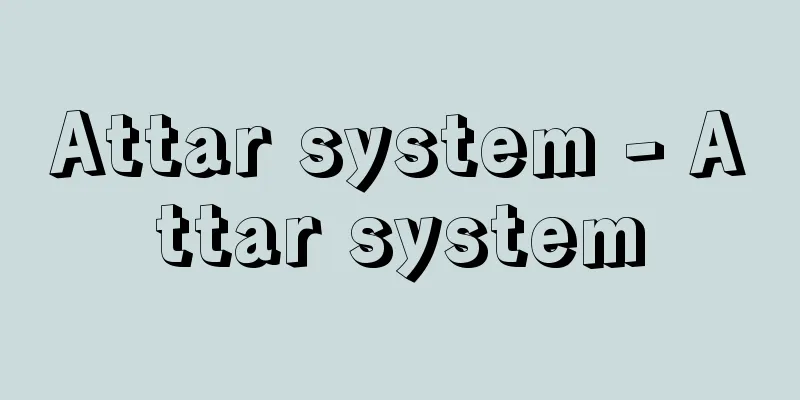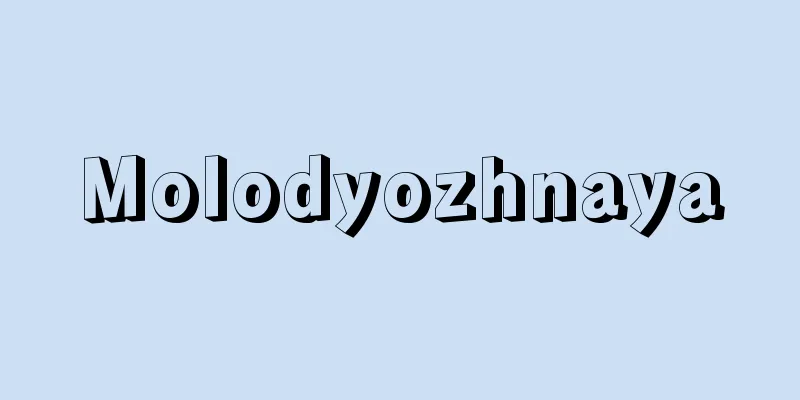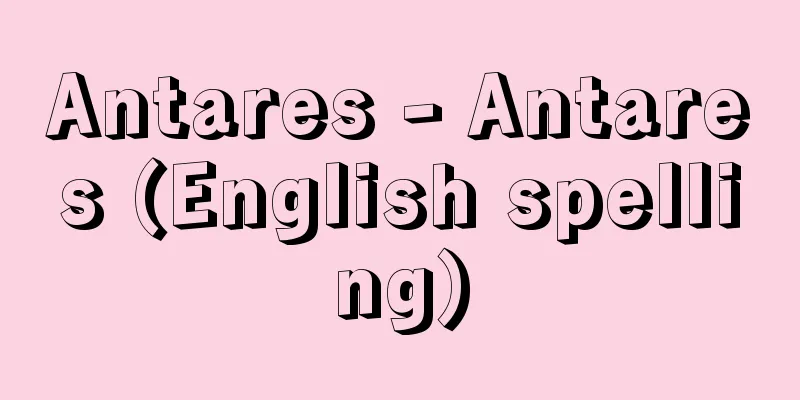Play - Gikyoku

|
It refers to the dramatic content (plot development) that actors perform on stage in front of an audience, mainly consisting of the dialogue and monologues (lines) of the characters, with supporting direction, acting, and stage specifications (stage directions). It is one of the basic components of theater, along with actors, audiences, and the stage. It is generally used in almost the same sense as screenplay or script, but whereas script refers to works that are directly aimed at performance and directly connected to the stage, a play emphasizes the ideological content of the work written by the author (playwright) and often refers to a work that maintains artistic quality that can also be appreciated as a literary work. This word has been used in China since the Song and Yuan dynasties, and originally meant songs from zaju and zaju (popular performing arts that centered on song and were popular with the common people). In Japanese Kabuki, they were called ledgers or original copies, but in the early Meiji period, the word 'play' was used as a translation of the European word 'drama', and from the end of the Meiji period onwards, plays in which the dramatic content of a play was written down and put into print came to be commonly referred to as 'plays.' The word 'drama' comes from the Greek word 'dran', meaning 'to do or act,' and refers to the actions of actors (the details of the event, the development of the plot) when they act out an event for the audience using their own bodies. [Hiroyuki Fujiki] Types of playsFrom ancient Greek drama, Shakespeare in the Elizabethan era, and Racine in the French Classical era, plays were mainly written in verse (poetry) and were considered a literary genre in Europe. Along with epic poetry, which objectively describes events, and lyric poetry, which subjectively expresses the author's feelings, dramatic poetry (especially tragedy), which should be performed by actors, was thought to be the highest form of literature, combining the two. In the 18th century, Diderot advocated bourgeois drama as a genre intermediate between traditional tragedy and comedy, and as the emerging bourgeois class became the protagonists and the everyday lives of ordinary people began to be featured on stage, prose plays increased and became mainstream in the 19th century. Dialogue drama, which is mainly dialogue, gradually developed independently from the 16th and 17th centuries, as opera, which is mainly song, and ballet, which is mainly dance, were separated and further purified, and it was established as a central and orthodox genre of theater. This European concept of drama as a literary genre did not exist in the East, including Japan, and theater, a form of performing arts centered on song and dance, continued even in modern times. Originally, a play was written by an author to be performed on stage, but there also appeared Lesedrama (German: translated as book drama or desk drama), which was written as a reading material without expecting direct performance, using the form of dialogue as a means of expression. Some of these, like the dramatic poems written by English Romantic poets in the 18th and 19th centuries, lack dramatic structure and are lengthy and unsuitable for performance, but there are also cases, like Musset's plays and Goethe's Faust, where plays written without the author expecting them to be performed are performed in later generations and achieve great success. On the other hand, there are many well-made plays with complex plot development and excellent technique that are well-performed and well-received by the audiences of their time, but do not leave a name for posterity if they lack ideas or content. The meaning of a play's performability (theatricality) and content (literature) varies considerably depending on the era, social environment, and theatrical situation. [Hiroyuki Fujiki] Characteristics of the playPlays also come with many constraints. In modern times, with the increasing mechanization of stage machinery and equipment, and the penetration of film and television, the fixed image of the traditional stage that audiences had is being shattered, allowing playwrights to use techniques with a great deal of freedom. However, a play is usually performed for around two and a half to three hours, and there is a time constraint that everything must be packed into that time. Also, the spatial constraint of having a living, life-sized person appear on stage and speak in his own voice has fundamentally remained unchanged. Aristotle was the first to point out these constraints, theatrical structure, and characteristics, by inductively deriving the issues from ancient Greek drama. In his Poetics, he described tragedy as a drama that expresses events within a certain period of time and that actors directly express them in front of the audience in the form of performing them, clarifying the difference between epic poems and stories, and also laying out the basic theory of drama, such as the fact that events have a certain magnitude and completeness (structured with a beginning, middle, and end), the importance of discovery and reversal as parts of the plot, and the cathartic (purifying) effect of drama. This theory caused misunderstandings in the 17th century French classical drama era, and the law of three unities (law of three unities) was standardized, which states that a play should be performed in one day, in one place. However, in the 19th century, the German Freytag, who followed the trend of Hegelian aesthetics and saw the essence of drama in the conflict of wills, analyzed plays from ancient to modern times in The Art of Drama (1863) and explained that a play is made up of five parts: the beginning, the rise, the climax, the descent, and the catastrophe. This became the established theory of modern drama theory. In Japanese drama theory, there is Zeami's "Nō Sakusho" (1423), which explains the five-stage structure of Noh, "Johakyu", and "Kezairoku" (1801), which describes the methods of vertical (world) and horizontal (instrument) that are the basis of Kabuki drama theory. In modern times, Hisamatsu Sadahiro, a recent returnee from Japan, introduced European drama theory in "German Drama Summary" (1887), which was further expanded upon by Mori Ogai, Ishibashi Ningetsu, and others. Osanai Kaoru also translated and introduced William Archer's theory on crisis in "Gikyoku Saho" (1918). [Hiroyuki Fujiki] Modern dramaWith the backdrop of the disintegrating civil society at the end of the 19th century, realistic plays by Ibsen and Strindberg dealt head-on with the problems that arose from it, but the nature of drama changed dramatically in the 20th century. Expressionism, which began in Germany around the time of World War I, sought to strongly express the subjectivity of the individual, Dadaism, which sought to destroy the framework of existing theater and make all values meaningless, Brecht's epic drama, which sought to elevate it to a drama of recognition through the alienation effect, and absurdist theater after World War II, have shown a great transformation, leading to a movement to restore the actor's body. Modern drama, which points to the collapse of communication through language and uneasy human relationships as if to represent the modern state of human alienation, is forcing a reexamination of the traditional form of dialogue-centered drama and the role played by drama with a literary dominance in theater. [Hiroyuki Fujiki] "Lectures on Theatre Theory 5: Drama Theory" edited by Tsugami Tadashi, Sugai Yukio, et al. (1977, Shiobunsha)" ▽ "Dissecting Drama" by M. Esslin, translated by Yamauchi Tomio (1978, Kinokuniya Shoten)" ▽ "Encyclopedia of World Theatre Theory" edited by Ando Shinya, Oshima Tsutomu, et al. (1979, Hyoronsha)" ▽ "The Theory of Contemporary Drama" by P. Schondi, translated by Ichimura Hitoshi and Maruyama Takumi (1979, Hosei University Press)" ▽ "Lectures on Japanese Theatre" edited by Suwa Haruo and Sugai Yukio, 8 volumes (1992-98, Benseisha)" ▽ "Can Today's World Be Recreated by Theatre? A Collection of Essays on Brecht's Theatre" edited and translated by Senda Koreya (1996, Hakusuisha)" ▽ "The Current State of Theatre Theory" edited by the Western Comparative Theatre Research Group (1999, Hakuohsha) [References] | | | | | | | | | | | | | | | | | | | | | |Source: Shogakukan Encyclopedia Nipponica About Encyclopedia Nipponica Information | Legend |
|
舞台で観客を前にして俳優が演じる劇的内容(筋の展開)を、登場人物の対話・独白(台詞(せりふ))を主とし、演出・演技・舞台の指定(ト書)を補助的に加えて記したものをいう。俳優、観客、舞台とともに演劇の基本的構成要素の一つである。一般には脚本、台本とほぼ同じ意味で使われるが、それが直接上演を目ざした、舞台に直結した作品をいうのに対し、戯曲は作者(劇作家)の書いた作品の思想性を重視し、文学作品としても鑑賞できるような芸術性を保った作品をさしていう場合が多い。この語は、中国で宋(そう)・元の時代から用いられ、もとは雑劇や雑戯(歌が中心で庶民に好まれた大衆的な芸能)の歌曲を意味していた。日本の歌舞伎(かぶき)では台帳、正本(しょうほん)などとよばれていたが、明治初年にヨーロッパのドラマdramaの訳語として戯曲の文字があてられ、明治末以降演劇の劇的内容を文字で記し活字にした劇作品を広く戯曲と呼び習わすようになった。ドラマは、ギリシア語の「行う・行為する」を意味するドランdranを語源にもち、俳優が自分の肉体で観客に、あるできごとを演じてみせる、その人物の行為(できごとの事柄、筋の展開)をさしていう。 [藤木宏幸] 戯曲の種類古代のギリシア劇をはじめ、エリザベス朝時代のシェークスピア、フランス古典主義時代のラシーヌなど、戯曲はおもに韻文(詩)形式で書かれており、ヨーロッパでは文学の一ジャンルとみなされてきた。できごとを客観的に述べ伝える叙事詩、作者の心情を主観的に表す叙情詩とともに、俳優によって演じられるべき劇詩(とくに悲劇)は、両者を総合した文学の最高位を占めるものとの考えも生まれた。18世紀にディドロが、従来の悲劇と喜劇の中間的なジャンルとしての市民劇を提唱し、やがて新興の市民階級が主人公となり、庶民の日常的な生活が舞台に取り上げられるようになると、散文による戯曲が増加し、19世紀には主流となった。台詞を主にした対話劇は、16、17世紀からしだいに、歌を主としたオペラ、舞踊を主としたバレエが分離し、独自な発展をみたことで、いっそう純化され、演劇のなかでも中心的で正統的なジャンルとして確立していった。こうしたヨーロッパの、文学の一ジャンルとしての戯曲という概念は、元来、日本を含めた東洋にはなく、歌や踊りを主にした芸能、演劇が近代に入ってからも継続することになる。 戯曲は本来、舞台で上演するために作者によって書かれるものであるが、直接上演を予想しないで、対話という形式を一つの表現方法として用い、読み物として書かれたレーゼドラマLesedrama(ドイツ語。書物戯曲、机上戯曲と訳す)も出現する。それは18、19世紀のイギリス・ロマン派の詩人たちが書いた劇詩のように、劇的な構成を欠き冗長で上演に不適当な場合もあるが、ミュッセの戯曲やゲーテの『ファウスト』のように、作者が上演を予想しないで書いても、後代上演されて大きな成功を収める場合がある。また一方に、入り組んだプロット(筋)の展開と技巧の勝ったウェルメイド・プレイ(うまくこしらえられた芝居)で、その時代の観客に迎えられ喝采(かっさい)を博した上演性に富む作品であっても、思想や内容が希薄であれば、後世に名をとどめえない作品も数多くある。戯曲のもつ上演性(演劇性)と内容性(文学性)の意味は、時代、社会環境、演劇状況によってかなり異なってくるのである。 [藤木宏幸] 戯曲の特質戯曲はまた多くの制約を伴っている。現代では舞台機構や設備などの機械化が進み、映画やテレビの浸透で、観客の固定化した従来の舞台のイメージが破られてきていることもあって、作者はかなり自由な手法を駆使することが可能となった。しかし戯曲の上演時間は通常2時間半から3時間前後であり、そのなかにすべてのことを折り込まなければならないという時間的な制約がある。また生身で等身大の人間が舞台に登場し、肉声で語っていくという空間的な場での制約も基本的には変わっていない。こうした制約や劇構造、特質についていち早く指摘したのは、古代ギリシア劇から帰納的に課題を導き出したアリストテレスである。彼は『詩学(創作論)』で、悲劇を対象に、劇がある一定の時間内のできごとを表し、俳優がそれを実行する形式で観客の前で直接に表現することを述べて、叙事詩や物語との差違を明らかにし、またそのできごとが、ある大きさと完結性(初め・中・終わりという構成)をもつこと、筋の部分である発見と反転の重視、劇の及ぼす効果としてのカタルシス(浄化)作用など、戯曲の基礎的な理論づけを行っている。この理論から、17世紀のフランス古典主義演劇の時代には誤解を生じ、劇は1日のうちに、一つの場所で、一つの筋を取り扱うべしとする三単一の法則(三一致の法則)が規範化された。しかし、19世紀には、ヘーゲル美学の流れをくみ、意志の対立葛藤(かっとう)に戯曲の本質をみるドイツのフライタークが、『戯曲の技法』(1863)において古今の戯曲を分析して、筋の発端・上昇・頂点・下降・破局の5部分から戯曲がなっていることを説き、近代の戯曲理論の定説となった。日本の戯曲論では、能の「序破急(じょはきゅう)」五段構成を示した世阿弥(ぜあみ)の『能作書』(1423)や、歌舞伎の作劇の基本となる竪(たて)筋(世界)・横筋(趣向)の方法などを記した『戯財録(けざいろく)』(1801)があるが、近代に入ると新帰朝者の久松定弘が『独逸(ドイツ)戯曲大意』(1887)でヨーロッパの戯曲理論を紹介し、さらに森鴎外(おうがい)、石橋忍月(にんげつ)らがこれを深めた。また小山内薫(おさないかおる)が、危機説にたつウィリアム・アーチャーの論を『戯曲作法』(1918)で翻訳紹介している。 [藤木宏幸] 近代以降の戯曲19世紀末の解体期の市民社会を背景に、そこに派生する問題を真正面から扱ったイプセン、ストリンドベリなどの写実的戯曲を経て、20世紀に入ると戯曲の様相は一変する。第一次世界大戦前後のドイツに始まる、あくまでも個人の主観を強烈に表出しようとする表現主義、既成演劇の枠組みを打破してすべての価値を無意味に化そうとするダダイズム、異化効果によって認識の劇に高めようとするブレヒトの叙事詩的演劇、さらに第二次世界大戦後の不条理演劇から、俳優の肉体復権の動きへと、大きな変容をみせている。現代の人間疎外の状況を表象するかのように、言語による伝達関係の崩壊や、不安な人間関係を指し示す現代の演劇は、旧来の台詞を中心とした戯曲のあり方や、演劇における文学性優位の戯曲の果たした役割に再検討を迫るものとなっている。 [藤木宏幸] 『津上忠・菅井幸雄他編『演劇論講座5 戯曲論』(1977・汐文社)』▽『M・エスリン著、山内登美雄訳『ドラマを解剖する』(1978・紀伊國屋書店)』▽『安堂信也・大島勉他編『世界演劇論事典』(1979・評論社)』▽『P・ションディ著、市村仁・丸山匠訳『現代戯曲の理論』(1979・法政大学出版局)』▽『諏訪春雄・菅井幸雄編『講座日本の演劇』全8巻(1992~98・勉誠社)』▽『ベルトルト・ブレヒト著、千田是也編・訳『今日の世界は演劇によって再現できるか――ブレヒト演劇論集』(1996・白水社)』▽『西洋比較演劇研究会編『演劇論の現在』(1999・白凰社)』 [参照項目] | | | | | | | | | | | | | | | | | | | | | | | |出典 小学館 日本大百科全書(ニッポニカ)日本大百科全書(ニッポニカ)について 情報 | 凡例 |
<<: Drama music - gikyokuongaku (English)
Recommend
Legal basis for taxation
...Article 84 of the Constitution of Japan also d...
Calcium Carbide - Tanka Calcium
CaC 2 (69.10). Its IUPAC name is calcium dicarbid...
babakotou
…The name Indri comes from the French naturalist ...
Applet - Applet
Accessory JAVA applet A Java program that runs in ...
planetary boundary layer
…If no disturbance occurs, the height at which gr...
Overtax - Casey
A transit tax on goods that began to be imposed in...
Offshore Race
…Today, it is common for small diesel engines to ...
Weirdness - Kimyousa
→Strangeness Source : Heibonsha Encyclopedia About...
Pope Johannes XXIII (English spelling)
…Leo XIII (1878-1903) opened a close relationship...
Ampera - Ampera
(From Portuguese ampero or Malay ampela ) 1. A per...
Supply - supply
〘noun〙① To give something. To offer. Gukyu. In the...
Spherical bar gauge
...the end surface is either flat, cylindrical, o...
Ex chathedra (English spelling)
...By extension, it also refers to the authority ...
Sodium Bromide - Sodium Chloride
NaBr (102.89). It is obtained by reacting an aque...
European hazel
...Two species of hazel are distributed in Japan,...









